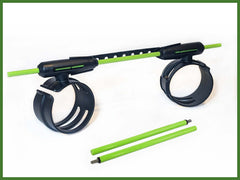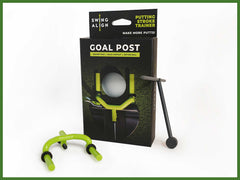A Simple Guide to Golf Swing Basics
Every golfer has sought out help with their golf swing at one point or another. Whether you are new to the game or just need some help with some golf swing fundamentals, you are in the right place. We’ll give you some tips to help your golf swing and eliminate some of the frustrations that come from inconsistent play.
Golf Swing Setup Tips
Before you even think about making a swing, you need to have your grip and stance figured out. It’s important to make sure both of these are setup correctly as you cannot swing properly without good technique.
Stance

The golf stance is relatively simple. Start by making sure your feet are about shoulder width apart, and make sure you’re parallel to your starting line. Get in an athletic position with your lower body, making sure you feel sturdy over the golf ball. Your knees should be slightly bent and you should feel your weight in the middle of your feet.
Bending at the waist, keep your hips back and let your arms hang comfortably below you. The grip end of the golf club should line up with your toes, and your arms should form a triangle with your chest.
The ball will be positioned differently depending on which club you’re hitting. The longer the club, the further forward (towards your front foot) the ball should be. Driver should be even with the inside of your lead foot, while pitching wedge should be more in the middle of your feet.
Grip

Choosing grip is a matter of personal preference, and there are three options to choose from. There is a lot of hand placement discussion in this section. For right-handers, your top hand will be your left hand and your bottom hand is your right. Left-handers will have their right hand as their top hand and left as their bottom hand.
- Baseball grip - The first grip is the ten-finger grip, or baseball grip. As the name suggests, this grip involves holding the club with all ten fingers, like a baseball bat. It is typically only recommended for beginners, but its fundamentals are applicable to every grip. Right-handed players will have their left hand on the top of the club, while left-handed players will have their right hand on top of the club. Your other hand will be placed immediately below it, with the index finger of your top hand and pinky of your bottom hand touching. The thumb from your top hand should be placed on top of the grip and it will be covered up by your bottom hand.
- Overlap grip - The overlap grip is very similar to the baseball grip, but instead of having all ten fingers on the grip, the pinky finger of your bottom hand will be placed on your top hand. Gripping the club with your top hand, place your pinky finger of your bottom hand in the crest of your index and middle fingers on your top hand. The rest of the grip will remain the same as the baseball grip.
- Interlock grip - Instead of placing the pinky finger of your bottom hand on top of your top hand, you are going to interlock it with the index finger of your top hand. Grip the club with your thumb, pinky, ring, and middle fingers of your top hand, and point your index finger up. Then, interlock your index finger with the pinky from your bottom hand.
Grip Do’s and Don'ts
Do - Position your top hand so that you can see two knuckles on that hand as you look down. Any more or less and your grip will be too weak or too strong.
Don’t - Turn your bottom hand too far on top of the club. This weakens the grip. The v made between your thumb and index finger of your bottom hand should point at your trail shoulder.
Do - Be mindful of your thumbs. Your top thumb should be on the side of the grip that is facing away from your target, and your bottom thumb should be facing the target.
Don't - Grip the club too tightly. This causes tension in the swing and leads to inconsistencies.
Do - Feel most of the pressure in your grip in your top three fingers. These will be your pinky, ring, and middle fingers on your top hand.
Step-by-Step Golf Swing Basics
Once your grip and stance are in a good place, it’s time to actually start making some swings. There are a million swing thoughts that you can have during a golf swing, but try to stay focused on one or two thoughts. It’s very important to keep your mind focused throughout the swing. Work on drills slowly and don’t get frustrated because it isn’t all coming together quickly.
The following paragraphs will take you step-by-step through the golf swing and give you some basic swing thoughts to consider when practicing your swing.
1. The Takeaway

The takeaway is a quick, but vital part of the golf swing. If you get the club off track, it is difficult to get it corrected.
Your swing thought should be to take the club back in one piece. This means moving your chest and arms together away from the golf ball, keeping the triangle of the three intact until the club is waist high. Don’t just bend your wrist to get the club back. Let your body turn and do the work. The club should be parallel to your target line when it reaches your waist.
The Backswing

After you get the club started with your takeaway, it’s time to complete the backswing. This involves keeping the club on plane and ensuring that the club isn’t too far inside so you can attack the ball on the downswing.
Keeping your head down, turn your shoulders so that the club turns behind you. Make sure you aren’t turning so far that the club actually points at the ground. Your back shoulder should be nice and high in the air, higher than your lead shoulder, to ensure that you are keeping the club on plane.
Your lower body should be following the upper body in the backswing as well. Turn your hips away from the golf ball and into the inside of your back leg. You should feel the pressure on the side of your foot and quadricep muscle.
The Downswing

While your backswing is all about storing up energy, the downswing is about exerting that energy onto the golf ball to propel it forward.
The downswing starts with your lower body. Right as you reach the top of your backswing, fire your hips towards the golf ball. This will drive your knees and upper body with you. Keep your lead shoulder and chest facing the golf ball and do not pull them up and out of the swing. The elbow of your trail arm (right for right handers, left for left handers), should also tuck into your back hip. This keeps the club from coming over the top and producing a slice.
The Follow-Through

After impact, it’s important to keep the momentum through the rest of your swing. To use a baseball term, feel as though the club is driving out to center field. The worst thing you can do is decelerate into and through the golf ball. Keep your speed through the ball and rotate. Keep your eye on the ball through impact and finish with the club nice and high on your follow-through.
Practice Golf Basics with Swing Align!
Regardless of which part of your golf swing needs work, Swing Align will help you improve your swing. It’s simple design gives you instant feedback and lets you know if what you are practicing is working.
Simply put, Swing Align is the best tool for practicing the basics of the golf swing. It helps you keep the club on plane, encourages proper mechanics, and allows you to address problem areas in your golf swing. Whether you need help with your takeaway or transitioning to your downswing, give Swing Align’s full collection of products a try. You’re sure to see improvements in no time!
















